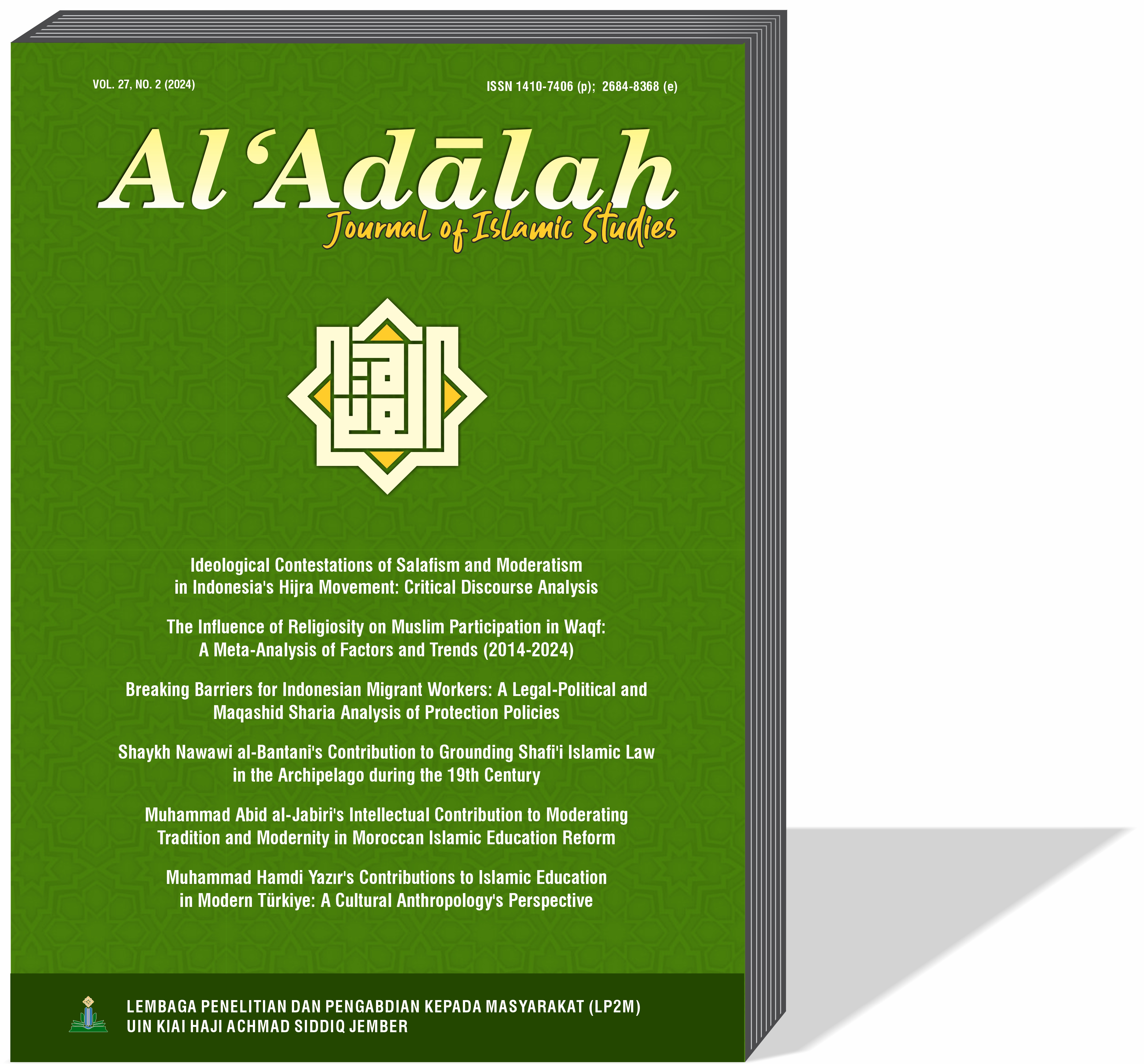Breaking the Glass Ceiling for Indonesian Migrant Workers: Legal-Political and Maqasid al-Shariah Analysis of Protection Policies
DOI:
https://doi.org/10.35719/aladalah.v27i2.528This research addresses the significance of protecting migrant workers through the lens of legal politics and maqasid al-shariah. Migrant workers, particularly women, face various structural challenges that create a “glass ceiling,” limiting their access to rights and welfare. Addressing gaps in prior research that largely focus on regulatory frameworks, this study highlights the relevance of maqasid al-shariah as a holistic approach to labor migration policies. Through a normative qualitative analysis of Law No. 18 of 2017 on the Protection of Indonesian Migrant Workers and secondary data sources, this study demonstrates that the PPMI Law aligns with maqasid al-shariah by addressing legal, social, and economic protections. These protections correspond to hifzh al-aql (preservation of intellect), hifzh an-nasl (preservation of family), and hifzh al-mal (preservation of wealth). The findings affirm the law’s dual objectives: securing workers' welfare and aligning national policies with Islamic jurisprudence. Theoretically, this research contributes to the integration of maqasid al-shariah and legal-political analysis, offering a nuanced perspective on migrant worker protection. Practically, it informs policy-makers on enhancing labor migration frameworks by aligning them with maqasid al-shariah. Future research should incorporate field data to evaluate the law's implementation and explore its comparative applicability across diverse sociopolitical contexts.
Downloads
References
Afriska, A. E., Zulham, T., & Dawood, T. C. (2018). Pengaruh tenaga kerja Indonesia di luar negeri dan remitansi terhadap PDB per kapita di Indonesia. Jurnal Perspektif Ekonomi Darussalam, 4(2), 231–248. https://doi.org/10.24815/jped.v4i2.12947
Al-Shatibi. Al-muwafaqat fi uşul al-shariah. Dar al-Kutub al-ilmiyyah, 2001.
Alias, M. N., Abdullah, M. N., Kamis, M. S., Afandi, A. J., & Alias, N. (2024). Scientific approach as the basis for the formation of maqāsid al-sharī‘ah concept and principles: a comparative study. Malaysian Journal of Syariah and Law, 12(2), 350–363. https://doi.org/10.33102/mjsl.vol12no2.568
Alpaslan, B., Kayaoglu, A., Meckl, J., Naval, J., Vanore, M., & Ziesemer, T. H. (2021). Economic effects of remittances on migrants’ country of origin. In Kourtit, K., Newbold, B., Nijkamp, P., Partridge, M. (Eds.), The economic geography of cross-border migration (pp. 449–483). Springer. https://doi.org/10.1007/978-3-030-48291-6_20
Alziyadat, N., & Ahmed, H. (2019). Ethical decision-making in Islamic financial institutions in light of Maqasid al-Sharia: A conceptual framework. Thunderbird International Business Review, 61(5), 707–718. https://doi.org/10.1002/tie.22025
Anam, M. Z., Warsito, T., Al-Fadhat, F., Pribadi, U., & Sugito, S. (2021). Covid-19 and decent work: Online media coverage on Indonesian female migrant domestic workers in Malaysia and Taiwan. Sociología Y Tecnociencia, 11(2), 160–193. https://revistas.uva.es/index.php/sociotecno/article/view/5423
Anwar, K., Awang, M. S., & Sahid, M. M. (2021). Maqasid syariah menurut imam al-ghazali dan aplikasinya dalam penyusunan kompilasi hukum Islam di indonesia. Malaysia Journal Syariah & Law, 9(2), 75–87. https://doi.org/10.33102/mjsl.vol9no2.315
Arifin, Z. M. (2022). Politik hukum pembentukan undang-undang. EA Books.
Artina, N. (2022). Pengaruh tenaga kerja Indonesia, remitansi, dan inflasi terhadap pertumbuhan ekonomi di Indonesia. Forbiswira Forum Bisnis dan Kewirausahaan, 11(2), 338–357. https://doi.org/10.35957/forbiswira.v11i2.2245
Askari, H., & Mirakhor, A. (2020). Conceptions of justice from Islam to the present. Palgrave McMillan.
Aswindo, M., & Ras, A. R. (2020). Omnibus law cipta kerja dan prospek ketahanan pekerja migran Indonesia. Jurnal Kajian Stratejik Ketahanan Nasional, 3(2). https://doi.org/10.7454/jkskn.v3i2.10037
Auda, J. (2022). Maqasid al-shari’ah as philosophy of Islamic law. International Institute of Islamic Thought (IIIT).
Azam, M. (2015). The role of migrant workers remittances in fostering economic growth: The four Asian developing countries’ experiences. International Journal of Social Economics, 42(8), 690–705. https://doi.org/10.1108/IJSE-11-2013-0255
Boucher, A. (2023). Patterns of exploitation: Understanding migrant worker rights in advanced democracies. Oxford University Press.
Brown, C. (2010). On Amartya Sen and the idea of justice. Ethics & International Affairs, 24(3), 309–318. https://doi.org/10.1111/j.1747-7093.2010.00269.x
Chowdhury, E. K., Dhar, B. K., & Gazi, Md. A. I. (2023). Impact of remittance on economic progress: Evidence from low-income Asian frontier countries. Journal of the Knowledge Economy, 14(1), 382–407. https://doi.org/10.1007/s13132-022-00898-y
Damir-Geilsdorf, S., & Pelican, M. (2019). Between regular and irregular employment: Subverting the kafala system in the GCC countries. Migration and Development, 8(2), 155–175. https://doi.org/10.1080/21632324.2018.1479215
D’Amodio, A. (2020). Toward a human-centered economy and politics: The theory of justice as fairness from Rawls to Sen. Philosophies, 5(4), 44. https://doi.org/10.3390/philosophies5040044
Duran, J. (2024). Amartya Sen’s social justice. Metaphilosophy.
Eddyono, S. W., Hidayah, A., Darma, S. A., Badriyah, S., & Harsono, N. (2020). Gerakan advokasi legislasi untuk perlindungan pekerja migran Indonesia. Migrant Care.
Ella, G. (2019). Politik hukum penyusunan Perda DIY nomor 3 Tahun 2017 tentang pelaksanaan urusan pemerintahan yang menjadi kewenangan Daerah Istimewa Yogyakarta [Unpublished master's thesis]. Universitas Atma Jaya Yogyakarta.
Elviandri, E. & others. (2022). Perlindungan pekerja migran Indonesia di masa adaptasi kebiasaaan baru di Provinsi Jawa Tengah. Jurnal Pembangunan Hukum Indonesia, 4(2), 245–255. https://doi.org/10.14710/jphi.v4i2.245-255
Erou, A. (2020). Memahami kerangka Undang-Undang 18 Tahun 2017 tentang Pelindungan Pekerja Migran Indonesia. Greenpeace Indonesia, SBMI, PPI.
Fatimah T., S. N. (2020). Pencantuman status perkawinan dalam administrasi perkawinan di Kantor Urusan Agama perspektif maqāshid syarī’ah. Al’Adalah, 23(1). https://doi.org/10.35719/aladalah.v23i1.28
Goswami, S., & Sharma, A. (2022). Analysing Rawls theory of justice through Amartya Sen’s perspective. Indian J. Integrated Rsch. L., 2(1). https://heinonline.org/hol-cgi-bin/get_pdf.
Hakim, D. A., & Havez, M. (2020). Politik hukum perlindungan pekerja migran indonesia dalam perspektif fikih siyasah dusturiyah. Tanjungpura Law Journal, 4(2), Article 2. https://doi.org/10.26418/tlj.v4i2.41913
Hart, C. S. (2019). Education, inequality and social justice: A critical analysis applying the Sen-Bourdieu Analytical Framework. Policy Futures in Education, 17(5), 582–598. https://doi.org/10.1177/1478210318809758
Ibrahim, Y. S. (2014). An examination of the modern discourse on maqāsid al-sharī‘a. The Journal of the Middle East and Africa, 5(1), 39–60. https://doi.org/10.1080/21520844.2014.882676
Imron, A., Gassing, A.Q., Aidid, H., & Marilang. (2022). The implementation of Indonesian employment law in protecting the welfare rights of Indonesian migrant workers according to Islamic law. Jurnal Diskursus Islam, 10(2), 132–143. https://doi.org/10.24252/jdi.v10i2.30451
Indrayati, Y. (2021). Politik hukum perlindungan sumber daya genetik untuk pemanfaatan obat-obatan dalam sistem hukum Indonesia. Hukum, Politik, dan Kekuasaan, 1(2), 174–205. https://doi.org/10.24167/jhpk.v1i2.3142
Irwan, M. (2021). Kebutuhan dan pengelolaan harta dalam maqashid syariah. Elastisitas: Jurnal Ekonomi Pembangunan, 3(2), 160–174. http://doi.org/10.29303/e-jep.v3i2.47
Istiqomah, I., Tarmudi, T., Yusuf, H., Dewi, R., & Umboh, N. K. (2023). Analisis yuridis perlindungan hukum terhadap pekerja migran Indonesia di luar negeri. Action Research Literate, 7(10), 47–51. https://doi.org/10.46799/arl.v7i10.181
Kang, M., Park, J., Le, C. N., & Kang-Le, S. (2024). How glass ceilings and iron rice bowls create “glass bowls”: Gendered barriers and protections in public sector employment in South Korea. American Behavioral Scientist. https://doi.org/10.1177/00027642241242750
Kartika, G. N., & Noor, H. (2014). Konsep maqashid al-syari’ah dalam menentukan hukum Islam: Perspektif al-Syatibi dan Jasser Auda. Al-Iqtishadiyah: Ekonomi Syariah dan Hukum Ekonomi Syariah, 1(1), 50–69. http://dx.doi.org/10.31602/iqt.v1i1.136
Kumar, P., Pillai, R., Kumar, N., & Tabash, M. I. (2023). The interplay of skills, digital financial literacy, capability, and autonomy in financial decision making and well-being. Borsa Istanbul Review, 23(1), 169–183. https://doi.org/10.1016/j.bir.2022.09.012
Latham-Sprinkle, J., David, F., Bryant, K., & Larsen, J. (2019). Migrants and their vulnerability to human trafficking, modern slavery and forced labour. International Organisation for Migration. http://hdl.handle.net/1854/LU-8636089
Lim, S., & Basnet, H. C. (2017). International migration, workers’ remittances and permanent income hypothesis. World Development, 96, 438–450. https://doi.org/10.1016/j.worlddev.2017.03.028
Low, C. C. (2021). Legal reforms in protecting migrant workers’ welfare in malaysia: labor law and social security. Austrian Journal of South-East Asian Studies, 14(1), 59–80. https://doi.org/10.14764/10.ASEAS-0048
Luqman, L. R. K. (2022). Menakar rekonstruksi maqashid syariah: Telaah genealogis pendekatan system Jasser Auda. Politea: Jurnal Politik Islam, 5(1), 64–82. https://doi.org/10.20414/politea.v5i1.5042
Ma’arif, B. A. (2015, October 25). UU 39 Tahun 2004 tentang PPTKILN tak memiliki naskah akademik. Pusat Sumber Daya Buruh Migran (Migrant Worker Resource Centre). https://buruhmigran.or.id/2015/10/25/uu-39-tahun-2004-tentang-pptkiln-tak-memiliki-naskah-akademik/
Mahfud, Moh. (2020). Politik hukum di Indonesia. Rajawali Press.
Mantouvalou, V. (2023). Structural injustice and workers’ rights. Oxford University Press.
Mas’udah, S. (2020). Remittances and Lifestyle Changes Among Indonesian Overseas Migrant Workers’ Families in Their Hometowns. Journal of International Migration and Integration, 21(2), 649–665. https://doi.org/10.1007/s12134-019-00676-x
Maturrahmah, M., & Hamzah, A. S. (2023). Implementasi perlindungan pekerja migran Indonesia (PMI) pasca penempatan di luar negeri menurut PP No. 59 Tahun 2021. Private Law, 3(3), 831–844. https://doi.org/10.29303/prlw.v3i3.3498
Maulida, S., Santono, H., & Susilo, W. (2019). Perempuan pekerja migran: Aktor pembangunan yang tertinggal. Migrant CARE. https://migrantcare.net/wp-content/uploads/2019/09/SGDs_Highlight_Bahasa_Indonesia.pdf
Mehdi, A. (2019). Metrics of justice. In A. Mehdi, A shot of justice (pp. 51–85). Oxford University Press. https://doi.org/10.1093/oso/9780199490592.003.0002
Mita, N., Aswatini, Fitranita, Utami, D. W., & Saleh, R. (2021). Perlindungan pekerja migran Indonesia: Kesepakatan dan implementasinya. Yayasan Pustaka Obor Indonesia.
Muhamad, N. (2024, August 22). Daftar masalah yang diadukan pekerja migran Indonesia per semester I 2024. Databoks. https://databoks.katadata.co.id/index.php/ketenagakerjaan/statistik/66c6bb5aa582a/daftar-masalah-yang-diadukan-pekerja-migran-indonesia-per-semester-i-2024
Murti, A., & Syah, T. A. (2021). Menelaah pemikiran Jasser Auda dalam memahami maqasid syariah. Citizen: Jurnal Ilmiah Multidisiplin Indonesia, 1(2), 60–67. https://doi.org/10.53866/jimi.v1i2.9
Palmer, W. (2024). Labour market institutions for immigrants: The case of high-wage migrant workers in Indonesia. Asia & the Pacific Policy Studies, 11(3), e396. https://doi.org/10.1002/app5.396
Pholphirul, P. (2019). South–south labour migration and sustainable development: Implications for Southeast Asian countries. Sustainable Development, 27(1), 1–12. https://doi.org/10.1002/sd.1876
Probosiwi, R. (2015). Analisis undang-undang perlindungan tenaga kerja Indonesia di luar negeri. Kawistara, 5(2), 200–212. https://doi.org/10.22146/kawistara.7597
Putri, N. S. M. S., Fithriana, A., & Gaol, D. F. L. (2022). Upaya Badan Pelindungan Pekerja Migran (BP2MI) dalam menangani kasus kejahatan human trafficking di Nusa Tenggara Timur periode 2016-2019. Balcony, 6(1), 23–32. https://jom.fisip.budiluhur.ac.id/index.php/balcony/article/view/275
Rahardjo, S. (2000). Ilmu hukum. Citra Aditya Bakti.
Reza, Md. M., Subramaniam, T., & Islam, M. R. (2019). Economic and social well-being of Asian labour migrants: A literature review. Social Indicators Research, 141(3), 1245–1264. https://doi.org/10.1007/s11205-018-1876-5
Robinson, K. (2022, November 18). What is the kafala system? Council on Foreign Relations (CRF). https://www.cfr.org/backgrounder/what-kafala-system
Rother, S. (2017). Indonesian migrant domestic workers in transnational political spaces: Agency, gender roles and social class formation. Journal of Ethnic and Migration Studies, 43(6), 956–973. https://doi.org/10.1080/1369183X.2016.1274567
Safitri, D., & Wibisono, A. A. (2023). Keamanan manusia pekerja migran Indonesia: Ketidakamanan dan perlindungannya. Intermestic: Journal of International Studies, 7(2), 741–769. http://dx.doi.org/10.24198/intermestic.v7n2.17
Salamun, S., Simatupang, B., Ramlan, R., Respationo, S., & Erniyanti, E. (2024). Juridical analysis of human rights protection for Indonesian migrant workers shipped illegally: Research study at the Riau Islands Police Directorate. Literacy: International Scientific Journals of Social, Education, Humanities, 3(2), 123–137. https://doi.org/10.56910/literacy.v3i2.1680
Santoso, A. (2017). Migrant workers and ASEAN: A two level state and regional analysis. Routledge. https://doi.org/10.4324/9781315512457
Saputri, A. A. I., & Islamy, A. (2021). Nilai-nilai maqasid syariah dalam fungsi keluarga di tengah pandemi Covid-19. Al-Qisthu: Jurnal Kajian Ilmu-ilmu Hukum, 19(1), 1–15. https://doi.org/10.32694/qst.v19i1.899
Sen, A. (2009). The idea of justice. Penguin Books.
Senjaya, O., Santoso, I. B., & Pahlevi, M. R. (2023). Protection of women migrant workers from exploitation and trafficking. Proceedings of the 3rd International Conference on Law, Governance, and Social Justice (ICoLGaS), 820–827. https://doi.org/10.2991/978-2-38476-164-7_75
Serikat Buruh Migran Indonesia. (2024, July 24). Tinjauan pelaksanaan UU Pelindungan Pekerja Migran Indonesia: SBMI berikan potret evaluasi implementasi UU 18/2017 kepada DPR. https://sbmi.or.id/tinjauan-pelaksanaan-uu-pelindungan-pekerja-migran-indonesia-sbmi-berikan-potret-evaluasi-implementasi-uu-18-2017-kepada-dpr
Sil, J. (2020). A critical analysis of social justice as the basis of policy making in the light of arguments by Amartya Sen. Public Policy and Administration Research, 10(5), 44–46. https://iiste.org/Journals/index.php/PPAR/article/download/52613/54373
Soetjiptio, A. (2017). Kebijakan negara terhadap PRT migran di Indonesia: Telaah gender dan hubungan internasional. Jurnal Masyarakat dan Budaya, 19(1), 45–58. http://dx.doi.org/10.14203/jmb.v19i1.388
Solechan, S., Utami, T. R., & Azhar, M. (2020). Upaya meningkatkan jaminan perlindungan pekerja migran Indonesia. Administrative Law and Governance Journal, 3(1), 153–161. https://doi.org/10.14710/alj.v3i1.153-161
Solikin. (2012). Menguak pemikiran Jasser Auda tentang filsafat hukum Islam. Al’Adalah, 15(2), 183–200. https://doi.org/10.35719/aladalah.v15i2.197
Südüpak, Ö. B. & Şentürk, I. (2024). Gender distribution and wages in the job search process: Glass ceiling theory. Journal of International Management Educational and Economics Perspectives, 12(2), 104–122. https://dergipark.org.tr/en/pub/jimeep/issue/88594/1498067
Sumarta, S., Burhanudin, B., & Budiyanto, T. (2024). Maqasid al-syariah mendorong keadilan dan keseimbangan dalam hukum Islam. Khulasah: Islamic Studies Journal, 6(1), 16–31. https://doi.org/10.55656/kisj.v6i1.120
Tan, Y. (2024). Occupational and social mobility of skilled migrants: An intersectional analysis. Social & Cultural Geography, 1–21. https://doi.org/10.1080/14649365.2024.2420598
Wahyuding, W., & Hasan, H. (2021). Analisis perbandingan konsep fikih politik NU dan Muhammadiyah perspektif maqasid al-syari’ah. Shautuna: Jurnal Ilmiah Mahasiswa Perbandingan Mazhab, 2(3), 768–779. https://doi.org/10.24252/shautuna.v2i3.22330
Warassih, E. (2018). Peran politik hukum dalam pembangunan nasional. Gema Keadilan, 5(1), 1–15. https://doi.org/10.14710/gk.2018.3592
Wardah, F. (2021, December 24). Migrant care: Masih banyak masalah dalam pelaksanaan UU Perlindungan Pekerja Migran Indonesia. VOA Indonesia. https://www.voaindonesia.com/a/migrant-care-masih-banyak-masalah-dalam-pelaksanaan-uu-perlindungan-pekerja-migran-indonesia/6368324.html
Westra, E., Bonjour, S. A., & Vermeulen, F. F. (2023). Claiming a postcolonial differential citizenship. Contestation of family migration rights in the Netherlands in the wake of Suriname’s independence. Migration Studies, 11(3), 431–451. https://doi.org/10.1093/migration/mnad013
Widodo, H., & Belgradoputra, R. J. (2019). Perlindungan pekerja migran Indonesia. Binamulia Hukum, 8(1), 107–116. https://doi.org/10.37893/jbh.v8i1.343
Downloads
Section
License
Copyright (c) 2024 Aji Baskoro

This work is licensed under a Creative Commons Attribution-NonCommercial 4.0 International License.
This work is licensed under a Attribution-NonCommercial 4.0 International (CC BY-NC 4.0).

























 Al'Adalah licensed under Creative Commons Attribution-NonCommercial 4.0 International License.
Al'Adalah licensed under Creative Commons Attribution-NonCommercial 4.0 International License.